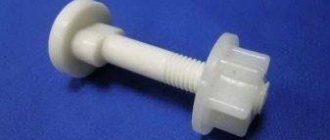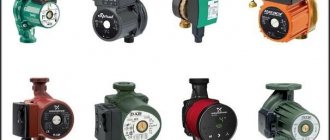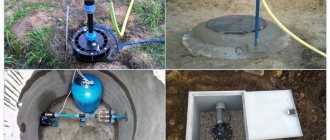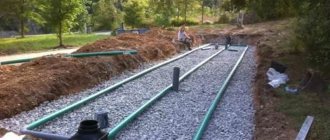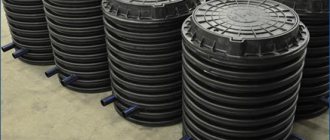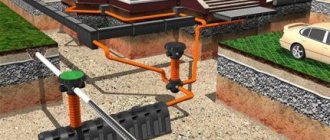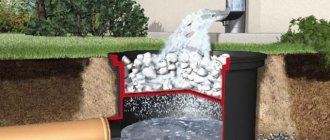A properly equipped drinking water well cannot be considered complete without a special unit - the head. Installing such a structure on a water tank will not only protect it from dirt and debris, but will also greatly simplify the use of the underground water supply system.
There is a misconception among owners of suburban housing that constructing a head is a waste of money, and the mouth of the tank can be wrapped in plastic film or covered with an old plastic barrel . However, this is absolutely not true, since such homemade covers do not protect the well from rising groundwater, which destroys the system and makes the liquid undrinkable.
Definition and necessity of using a head
A well head is a device for shaping the top of the casing pipe, which is placed in a mine opening when an autonomous water supply is created. This element is made in the form of a plug. It is placed at the end of the casing pipe. Its functions are the same as those of the superstructure above the well.
To clearly understand why a well head is needed, let’s consider the main points:
- Protection of the water source, since after installation, various debris, dust, dirt, and precipitation are prevented from entering the well. In winter, the so-called plug also prevents the formation of ice in the upper part of the borehole channel as a result of freezing of surface water.
- Sealing and reducing heat loss in winter. The cover fits tightly to the casing, which reduces the outflow of heat from the water source. Often, an additional heating cable is installed in the channel to completely prevent water from freezing. Due to the sealed connection between the plug and the casing, less electrical energy is required for heating.
The so-called plug is hermetically connected to the casing. Source homeli.ru
- Securely hold additional equipment thanks to its robust design. The cover allows you to attach a cable with a carabiner, to which the submersible electric pump is hooked. The plug is designed in such a way that it is possible to conveniently place the electrical cable to power the pump unit.
- Anti-theft protection for electric pump. After all, homeowners purchase most models for decent money. So, Grundfos SP9 costs about 2000 USD. e. The well cover is designed in such a way that it will be difficult for an inexperienced person to remove it and remove expensive equipment from the water source.
- Convenient connection of the pipeline from the pumping unit with the water supply system, which is laid to the house. The pipe is removed from the submersible equipment through a special hole in the well cover. It is located in its central part. After the pipeline is brought out through the hole in the head, it is cut in place and connected via a compression fitting to the water main.
Head connected to the water main using compression fittings Source eurobion.info
- Artificially maintaining the level in a water source. This is especially true for wells with shallow depths, in which, due to the low position of the water surface, a rarefaction area appears. It prevents the level from increasing.
There are traditional and improved models of well covers. Conventional devices do not allow you to quickly remove pumping equipment. To dismantle it, you must first unscrew the bolts to remove the cover from the casing. It is also necessary to disconnect the pump from the electrical cable and disconnect it from the pipeline. Because of this, the time required for maintenance and repair of submersible pumping equipment increases.
The design of new models includes a removable central part. Therefore, there is no need to waste time unscrewing bolts. In addition, a modern well pipe head has a terminal box. It allows you to quickly disconnect and connect the electrical cable.
Inverted headband with terminal box Source ecobt.ru
DIY pit construction
It is advisable to carry out excavation work in the off-season. During this period, the cooled, moist soil has a more dense structure and therefore does not crumble as much.
Digging a pit for a pit
To build a pit, a pit is dug 1.5-2 meters deep. Its dimensions should be 30-40 cm larger than the internal section of the structure being constructed. The bottom of the pit is leveled and thoroughly compacted. To protect the walls of the pit from water, they should be temporarily covered with film.
The most popular and simplest to make are rectangular and round pits.
The volume and overall dimensions of the pit are determined on the basis of freely placing the system elements and ensuring unhindered access to them
Whether it is necessary to concrete the bottom of the pit is a controversial issue. On the one hand, the monolithic “floor” is convenient for repair work and well maintenance.
It will prevent the penetration of flood waters into the annulus in the event of flooding of the structure in the off-season. However, soil movements that occur due to periodic freezing and thawing can significantly damage and distort it.
The best way to arrange the bottom of a pit is to build a “cushion” of crushed stone and sand 10-15 cm thick. Clay can be used as a waterproof layer. The holes formed as a result of soil shrinkage will only need to be leveled periodically.
Construction of the walls of the structure
The walls of the pit can be built using concrete rings for wells or broken bricks left after the dismantling of any building. To build walls of the required thickness, bricks are laid in one layer.
If desired, the walls of the structure can be made of concrete. To do this, formwork is knocked together from old unedged boards at a distance of 7-10 cm from the walls of the pit and a reinforcing mesh is installed. And then the formwork cavities are filled with concrete mortar.
During the construction of the walls of the pit, do not forget to leave a sufficient number of openings that will be needed for connecting cables and water supply
After 5-7 days, when the solution has acquired the necessary strength, the pit is covered with wooden beams or boards.
To reduce the likelihood of the walls of the pit being washed away by flood water, they are covered with a layer of gravel from the outside. It is better to lay out the inside of the structure with a layer of insulation, for example, sheets of extruded polystyrene foam.
The pit head can be covered according to your choice:
- concrete cover;
- metal hatch;
- a board shield reinforced with wooden blocks.
The pit cover is made removable so that it is possible to carry out a preventive inspection or carry out repair work at any time. For example: dismantle a pipe or lift a pump.
The pit is essentially a homemade caisson. Simple ways of arranging it are described in the article - How to make a caisson for a well with your own hands: design options and methods for their implementation
Types of heads
Typically, the construction of a water source in the form of a well is accompanied by digging a hole for a caisson. Its depth is necessarily greater than the freezing point of the soil. It is into the caisson that the casing pipe exits. First, its excess upper part is cut off, and then a well head is mounted on it.
The submersible pump is suspended on a cable on the so-called cover. Its power is selected depending on the required amount of water, which is taken from the source. In this case, the weight of the equipment can be 50 kg. Therefore, manufacturers make durable well covers. Moreover, they are created from different materials.
Plastic models
The plastic headband is an inexpensive model. It is used in conjunction with low-power pumps that submerge to a maximum of 50 m. The plastic device can hold a weight of no more than 200 kg.
Plastic cover for a well Source imir174.ru
Other product features include:
- small weight;
- affordable price, usually not exceeding 40 USD. e.;
- resistance to corrosion and chemicals;
- High functionality thanks to the terminal box and removable central cover.
Each plastic model is not capable of conducting electric current. However, if the device is made of low-quality polymer, then it will have increased fragility. Such a casing plug will not be able to withstand significant mechanical loads. There is even a greater chance that it will crack when the bolts are over-tightened.
Metal models
This type of device is a more durable borehole head. This is their main difference from plastic models. Metal options are also resistant to high and low temperatures, and are also designed for a longer period of operation.
Metal cover for a well Source sovet-ingenera.com
See also: Catalog of companies that specialize in water supply, sewerage and related work
Metal models also have disadvantages. The main one is low corrosion resistance. To improve this property, each metal sealed well head is coated with anti-corrosion compounds in the factory.
Today manufacturers produce:
- Stainless steel well covers are rarely found on the market compared to other models. The design of one of these options does not provide bolts for fixation. Moreover, this model can withstand weight up to 300 kg and is sold for about 30 USD. e.
- Steel well covers available for about $50. e. This option is capable of holding a maximum weight of 500 kg. However, steel models begin to rust if the integrity of their protective layer is damaged.
- Cast iron well covers are sold at about the same price as steel models. At the same time, they are heavier, but have comparable strength. Cast iron models are produced with galvanic, zinc or powder coating. It protects the base material from corrosion. The disadvantage of cast iron devices is their inability to withstand strong impacts.
Well plug made of cast iron Source mcgrp.ru
Buy or make your own
The well head is selected in the store. Standard models are offered, the installation of which is carried out according to the instructions. Products are made from plastic, steel or cast iron material.
The do-it-yourself well cover is made from the following materials: stainless steel or aluminum.
Each option must be airtight.
Professional and homemade designs have advantages and disadvantages:
When making it yourself, you choose available materials. When purchasing, you can choose products made of metal or plastic
The metal well cover is durable, and the plastic elements are corrosion resistant. When creating a structure on your own, it is recommended to pay attention to the tightness of the product. In professional production, the reliability of the element is tested. A do-it-yourself well head has the advantage of a low price. The disadvantage is errors during the creation and subsequent maintenance of the device.
Instructions on how to make your own well head
The cost of a purchased product is formed from several components: material, manufacturer, casing pipe size and seasonality. These products become more expensive during the summer season.
Design features of the heads
Every homeowner should have a good understanding of how a well head works and what it is needed for. This information will help you make an informed choice in favor of this or that device and not be disappointed in the purchase.
All produced standard headbands have a simple device. Their design contains:
- The cover is the main element of the device.
Almost all other parts are located on this part. The lid is made in the shape of a disk. It has an inner ring, the diameter of which is selected to match the cross-section of the casing pipe. There is a hole in the central part of the disk. It is used to secure the HDPE pipeline. Typically its diameter is 25, 32 or 40 mm.
On a note! When the well head is installed, the part of it that protrudes beyond the inner ring rests on the end of the casing pipe.
Manufacturers produce caps with different outer diameters. Standard models are used on casing pipes with a cross-sectional size of 90-160 mm. The design of each cover still contains holes for bolts and electrical cables.
One of the options for the head cover Source eco-kotly.ru
- A flange is a ring-shaped part that is equipped with holes for bolt fasteners.
This head element is put on the casing pipe. Then it is bolted to the cover. As a result, a single structure is formed, which is fixedly and hermetically fixed on the surface of the pipe.
- Carabiner for securing the cable.
It is needed for hanging submersible pumping equipment.
- The seal is in the form of a rubber ring.
This part is placed between the flange and the cover. It ensures sealing of the connection. Due to the rubber ring, the head is held tightly on the casing pipe.
- Eye bolts with a ring-shaped head.
One of these elements may be turned down. With this design, a cable is attached to it, on which the pump is suspended. Eye bolts facilitate installation work. They allow heavy pumps to be installed with a head when using a winch.
- A collet clamp that is located in the center of the device.
It is a compression fitting for permanently fixing the pipe.
Headband with central collet clamp in the form of a compression fitting Source cstor.nn2.ru
- Entry for electrical cables that prevents direct contact with the cover.
It is a pressure seal that is screwed into the headband. The result is a sealed hole. It meets all well operation requirements.
- Terminal box, which is not present on every headband.
This element is used to connect the wiring from the house to the power cable of the pump.
- Bolts for connecting the cover and flange together with a rubber sealing ring.
On a note! The water well head can be anti-vandal. With this option, the bolt heads are recessed into the lid. Therefore, a special wrench is used to unscrew and tighten them.
Features of selecting a well head
Before you put the head on the well, you need to select it correctly. To eliminate errors, the selection is made based on the device labeling. It is a combination of numbers and letters.
Headbands are marked with letters and numbers Source eco-kotly.ru
Each symbol used in the marking has its own meaning:
- OS – abbreviated designation for the well head;
- A – anti-vandal design;
- P – plastic device (the absence of a letter means that the product is made of metal);
- B - the letter symbol is used when marking Gilex products, which do not need to be completely disconnected from the casing pipe for dismantling or installing pumping equipment along with the cable, cable and pressure pipe (Jilex devices are equipped with a removable central part);
- 90-110 – outer diameter of well casing pipes;
- 25, 32 or 40 – the cross-sectional size of the collet clamp for fixing a plastic pipe of the same outer diameter.
On a note! Some manufacturers use their own combinations of symbols to mark heads. In this case, it is recommended to consult sellers in specialized stores or managers of the company where the well cap is purchased and installed.
Video description
The design features and subtleties of installation of the Gilex headband are described in the following video:
When choosing a plug head, take into account the advice of experienced specialists. Professionals recommend choosing a plastic model for a shallow well, in which a low-power pump will not be located very far from the surface of the earth. If a heavy electric pump is immersed to a considerable depth to pump a significant volume of water, it is better to purchase a metal cover for the well.
In addition, it is recommended to use the terminal box carefully when operating high-power pumping equipment. The reason for this advice is that this method does not ensure 100% reliability of the connection of wires with a large electric current. This causes the terminal strips to overheat. As a result, the electrical cable and the plastic well cover melt.
On a note! There is always high humidity in the caisson. Despite the reliable insulation of the terminal box, corrosion of the contacts still occurs. For this reason, sooner or later they may overheat or a short circuit in the electrical circuit may occur.
Most popular models
| Model | Advantages |
| "Gilex" | They are made of cast iron and plastic. The outer diameter ranges from 90 to 160 mm. |
| "Aquarius" | Due to the plastic filling, this model has certain limitations. Relevant for shallow wells. Capable of handling weights up to 200 kg. |
| Merrill | This is a representative of American production. Made from cast iron and plastic. Sold fully assembled and ready for installation immediately. |
| "Aquarobot" | Russian production. Creates a tight connection. Allows you to securely secure the pump. It is made of plastic and is designed for a weight of up to 200 kg. |
It is important to know! On sale you can find some models designed for a two-pipe or one-pipe system. The choice will depend on the features of your plumbing system.
Features of head installation
The homeowner must have complete information about the water source equipment in order to control its installation, which is performed by hired craftsmen. In particular, he must know what type of device the well head has, and how to install it correctly is recommended by experts.
If it is necessary to install a well cover together with an electric pump, it is better to contact a specialized company. After all, specialists have all the necessary tools and consumables. They will carry out the work in compliance with the rules of regulatory documents and guarantee the uninterrupted operation of the equipment.
Typically, installation begins with measuring the required length of electrical cable, pressure pipe and cable. These elements are then prepared taking into account the measurements taken.
Before installing the well head, prepare an electrical cable, cable and HDPE pipe of the required length Source eco-kotly.ru
Frost protection
To effectively operate a water source, it is not enough to know how to properly install the well head. It is also necessary to ensure that the water is protected from freezing. A so-called plastic plug is best suited for this. However, a polymer device is not 100% correct for this task when the water surface in a deep source is located next to the head.
To completely prevent freezing, additional insulation is performed. One option is to thermally insulate the walls, hatch and other elements of the caisson well, if it was previously created.
On a note! The caisson is installed when the top of the casing is below the ground surface. The well must be thermally insulated if a pump, automation, filter system, relay, or hydraulic tank are installed in it.
The caisson must be insulated when installing additional equipment Source global-bur.ru
Another insulation option is to create a heat-insulating box. This is a simple way to prevent water in a well from freezing. It is implemented by building a wooden box over the water source, which is insulated, for example, with basalt wool. Cheaper heat insulators are also used - polystyrene foam, rags and even paper.
Freezing of the water at the source can also be prevented by using a heating cable. It is placed in a pressure pipeline located in the well. For such protection to work effectively, the inlet opening is well sealed.
On a note! The best option for connecting a heating electric cable is to use a box with terminal blocks on the headband. Therefore, when choosing this option for protection against water freezing, it is recommended to purchase a well plug in this particular design.
Content
If this is a dacha designed only for summer living, then a lightweight summer version is a completely acceptable option, when the well practically has only a head above the mouth and is often not even equipped with a water supply.
If the house is intended for year-round use, then the low temperature season has to be taken into account. To ensure uninterrupted water supply at this time, a winter option is installed, which includes a caisson, a pit or a separate room built above the wellhead.
But all of the above work is very costly and time-consuming. All constructed facilities require periodic maintenance.
well adapter
An alternative to the above technical solutions that ensure year-round uninterrupted water supply to the house is to install a well without a caisson using an adapter. The specified technical solution involves placing all water treatment and supply equipment in the house itself, in a specially designated room in which positive temperatures are maintained. Most often, such a room is a boiler room. And in the well itself, only a special device is mounted - a well adapter, the design of which is very simple. It provides a sealed outlet from the outlet casing pipe, through which the water supplied by the deep-well pump enters the water supply system laid to the house.
Briefly about the main thing
A well cap is a cap or plug for the casing of an underground water source. The installation of the device is carried out to prevent debris from entering the source, reducing heat loss, more convenient installation of additional equipment, and preventing theft of the pump.
Manufacturers make headbands from metal and polymer. The design of the devices usually includes a bottom flange, tightening bolts, a top cover, an O-ring, a hole for the cable and HDPE pipes.
The installation of the head on the casing pipe is carried out at 90°. First, a flange and a rubber sealing ring are put on it. Then an electric pump, previously connected to the HDPE pipe and supply wires, is lowered into the source. These elements are output through the upper part of the headband. Finally, it is connected to the flange by tightening the bolts.
Protection against water freezing is provided by additional insulation of the head. To do this, build a thermally insulated box over the well or install a heating cable. If there is a caisson, its walls and hatch are insulated.
Ratings 0
Why is the cover installed?
Of course, you can simply cover the well with some unnecessary container, a piece of polyethylene, or wrap it with tape. But at the same time the well will remain unprotected.
Installing a cover helps solve a whole range of problems:
- the mouth of the water well will be reliably closed and hermetically sealed, which is especially important during snow melting or periods of prolonged precipitation;
- the structure will be protected from the ingress of surface groundwater, as well as foreign debris and objects;
- the underground part will not freeze even in the coldest winters;
- ensures reliable suspended mounting of the pump;
- will protect materials and equipment inside the well from theft.

